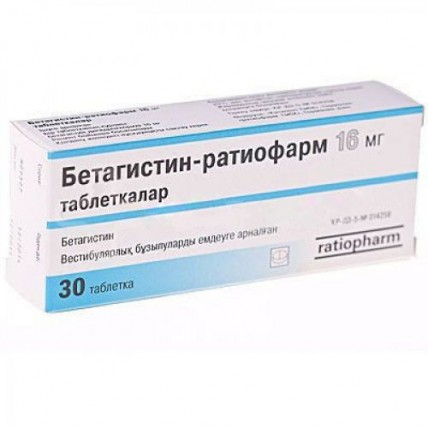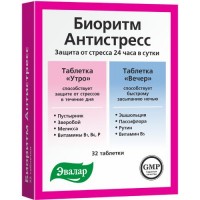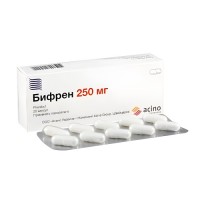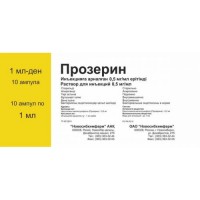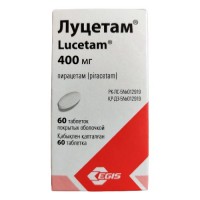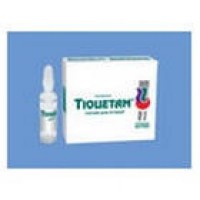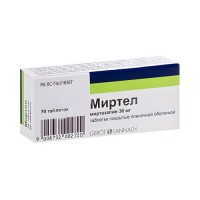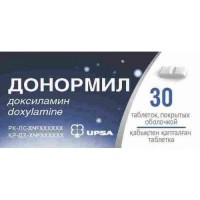Betahistine-ratiopharm 16 mg (30 tablets)
- $13.20
The instruction for medical use
of medicine
Betagistin-ratiopharm
the Trade name
Betagistin-ratiopharm
the International unlicensed
name Betagistin Lekarstvennaya a form
of the Tablet of 8 mg, 16 mg, 24 mg
structure
One tablet contains
active agent – a betagistin dihydrochloride of 8 mg, 16 mg, 24 mg
excipients: K 90 povidone, microcrystalline cellulose, lactose monohydrate, anhydrous silica gel, krospovidon, stearic acid.
The description
White or almost white, cylindrical, flat tablets, with slanted edges, with stamping of B8 (for a dose of 8 mg) or B16 (for a dose of 16 mg) on other party. White or gryaznobely round, biconvex tablets with risky on one party (for a dose of 24 mg)
Pharmacotherapeutic group
of Means for elimination of dizziness.
Code of automatic telephone exchange: N07CA01
the Pharmacological
Pharmacokinetics Later properties of intake of a betagistin a hydrochloride is absorbed quickly and completely.
Linking with proteins of plasma low. Betagistina a hydrochloride is quickly metabolized in a liver in an inactive main metabolite, 2-pyridylacetic acid and in dimethyl-betagistin.
It is brought to 90% through kidneys in the form of the main metabolite.
A pharmacodynamics
Betagistin is a synthetic analog of a histamine. Affects histamine H1 and H3 receptors of an inner ear and vestibular nuclei of central nervous system. Improves microcirculation and permeability of capillaries of an inner ear, increases a blood stream in basilar arteries, normalizes endolymph pressure in a labyrinth and a snail.
Indications
- Menyer's disease or Menyer's syndrome
- vestibular dizzinesses of various genesis (dizziness with nausea and vomiting, a ring in ears, a hearing loss)
the Route of administration and doses
the Recommended initial dose – 24 mg a day in 2-3 receptions (on 8 mg of a betagistin of a hydrochloride 3 times a day or on 16 mg 2 times a day). If this dosage is not enough, the daily dose can be increased up to 48 mg of a betagistin of a hydrochloride. The Prdolzhitelnost of administration of drug is defined by the attending physician.
Betagistin are not recommended for treatment of children and teenagers 18 years are younger. Safety and efficiency in this group of patients was not established in researches.
Special instructions
Influence on ability of driving or potentially dangerous mechanisms:
Due to the emergence of side effect in the form of fatigue the ability to reaction can be reduced that breaks ability to driving of the car and ability to operate the vehicles.
With care to use drug at patients from a peptic ulcer of a stomach and a duodenum in the anamnesis, bronchial asthma and a pheochromocytoma.
Side effect
Is rare:
- a headache, drowsiness
- feeling of heat
- heartbeat
- pain in anticardium, heartburn, nausea, vomiting
- rash, urticaria, an itching.
Contraindications
- hypersensitivity to a betagistin to a hydrochloride and/or to any of drug components
- a pheochromocytoma
- bronchial asthma
- pregnancy and peroid lactations
Interaction with other medicines
As betagistin is an analog of a histamine, simultaneous use of H1 of antagonists can cause mutual easing of effect of active agents.
Overdose
Symptoms: dryness in a mouth, nausea, vomiting, dyspepsia, an ataxy, face reddening, dizziness, the increased heartbeat, a bronchial spasm and hypostasis and after reception of very high doses can also happen convulsions.
Treatment: symptomatic (gastric lavage, use of activated carbon).
A form of release and packing
of the Tablet on 8, 16 and 24 mg No. 10 in blister strip packaging (blister), on 3 blisters together with the instruction for use in a cardboard box.
To Store storage conditions out of children's reach. To store at a temperature not above 25 °C.
A period of storage
For 8 mg and 16 mg - 3 years, for 24 mg – 2 years.
Not to apply after expiry date!
Prescription status
According to the prescription
Katalent GmbH Producer, Germany.for ratiopharm International GmbH, Germany.
of medicine
Betagistin-ratiopharm
the Trade name
Betagistin-ratiopharm
the International unlicensed
name Betagistin Lekarstvennaya a form
of the Tablet of 8 mg, 16 mg, 24 mg
structure
One tablet contains
active agent – a betagistin dihydrochloride of 8 mg, 16 mg, 24 mg
excipients: K 90 povidone, microcrystalline cellulose, lactose monohydrate, anhydrous silica gel, krospovidon, stearic acid.
The description
White or almost white, cylindrical, flat tablets, with slanted edges, with stamping of B8 (for a dose of 8 mg) or B16 (for a dose of 16 mg) on other party. White or gryaznobely round, biconvex tablets with risky on one party (for a dose of 24 mg)
Pharmacotherapeutic group
of Means for elimination of dizziness.
Code of automatic telephone exchange: N07CA01
the Pharmacological
Pharmacokinetics Later properties of intake of a betagistin a hydrochloride is absorbed quickly and completely.
Linking with proteins of plasma low. Betagistina a hydrochloride is quickly metabolized in a liver in an inactive main metabolite, 2-pyridylacetic acid and in dimethyl-betagistin.
It is brought to 90% through kidneys in the form of the main metabolite.
A pharmacodynamics
Betagistin is a synthetic analog of a histamine. Affects histamine H1 and H3 receptors of an inner ear and vestibular nuclei of central nervous system. Improves microcirculation and permeability of capillaries of an inner ear, increases a blood stream in basilar arteries, normalizes endolymph pressure in a labyrinth and a snail.
Indications
- Menyer's disease or Menyer's syndrome
- vestibular dizzinesses of various genesis (dizziness with nausea and vomiting, a ring in ears, a hearing loss)
the Route of administration and doses
the Recommended initial dose – 24 mg a day in 2-3 receptions (on 8 mg of a betagistin of a hydrochloride 3 times a day or on 16 mg 2 times a day). If this dosage is not enough, the daily dose can be increased up to 48 mg of a betagistin of a hydrochloride. The Prdolzhitelnost of administration of drug is defined by the attending physician.
Betagistin are not recommended for treatment of children and teenagers 18 years are younger. Safety and efficiency in this group of patients was not established in researches.
Special instructions
Influence on ability of driving or potentially dangerous mechanisms:
Due to the emergence of side effect in the form of fatigue the ability to reaction can be reduced that breaks ability to driving of the car and ability to operate the vehicles.
With care to use drug at patients from a peptic ulcer of a stomach and a duodenum in the anamnesis, bronchial asthma and a pheochromocytoma.
Side effect
Is rare:
- a headache, drowsiness
- feeling of heat
- heartbeat
- pain in anticardium, heartburn, nausea, vomiting
- rash, urticaria, an itching.
Contraindications
- hypersensitivity to a betagistin to a hydrochloride and/or to any of drug components
- a pheochromocytoma
- bronchial asthma
- pregnancy and peroid lactations
Interaction with other medicines
As betagistin is an analog of a histamine, simultaneous use of H1 of antagonists can cause mutual easing of effect of active agents.
Overdose
Symptoms: dryness in a mouth, nausea, vomiting, dyspepsia, an ataxy, face reddening, dizziness, the increased heartbeat, a bronchial spasm and hypostasis and after reception of very high doses can also happen convulsions.
Treatment: symptomatic (gastric lavage, use of activated carbon).
A form of release and packing
of the Tablet on 8, 16 and 24 mg No. 10 in blister strip packaging (blister), on 3 blisters together with the instruction for use in a cardboard box.
To Store storage conditions out of children's reach. To store at a temperature not above 25 °C.
A period of storage
For 8 mg and 16 mg - 3 years, for 24 mg – 2 years.
Not to apply after expiry date!
Prescription status
According to the prescription
Katalent GmbH Producer, Germany.for ratiopharm International GmbH, Germany.
